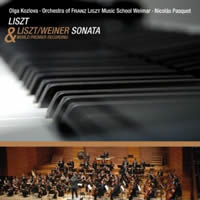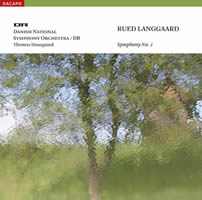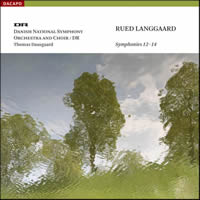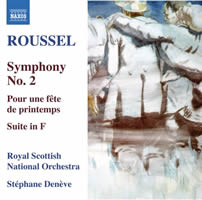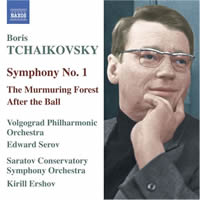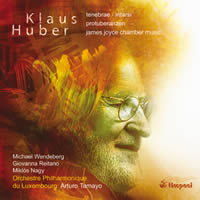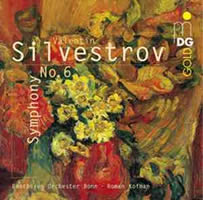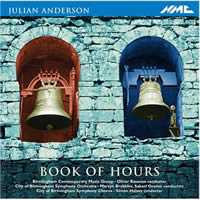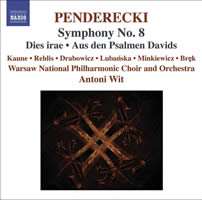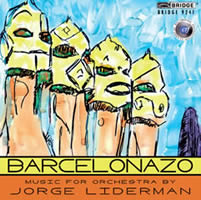Mostly Symphonies 7.
|
Grant Chu Covell [August 2008.]
Franz LISZT: Sonata for piano in B minor (1853); LISZT arr. Leó WEINER: Sonata for piano in B minor (arr. 1955). Olga Kozlova (pno); Orchester der Hochschule für Musik Franz Liszt Weimar, Nicolás Pasquet (cond.). Avi-Service for music AVI 8553012 (http://www.avi-music.de/). Distributed in the US by Allegro Music (http://www.allegro-music.com/). Franz SCHREKER: Intermezzo and Scherzo, Op. 8 (1900); Julius BÜRGER: Zwei Lieder für Bariton und Orchester (1919); Ernst KRENEK: Symphony No. 1, Op. 7 (1921). Dietrich Henschel (bar), Luzerner Sinfonieorchester, John Axelrod (cond.). Nimbus NI 5808 (http://www.wyastone.co.uk/nrl/). Distributed in the US by Allegro Music (http://www.allegro-music.com/). Another rainy-day project: I’m sure I’m not alone in harboring a desire to orchestrate Liszt’s B-minor Sonata. Weiner completed his arrangement in 1955, and this is apparently the first recording. The challenges and decisions are huge. Weiner’s choices at the first bars, an archetypical piano gesture alternating staccato B’s with sostenuto scales, could be debated. Later points demand and receive Wagnerian bombast; elsewhere, tender moments clearly belong to solo violin and harp, but what to do with the rapid broadsides and quicksilver arpeggios? Weiner sticks close to what Liszt himself might have done, Mazeppa perhaps a model. Consulting a possibly skewed representation of Weiner’s craft, this may be as modernistic as he got. (Solti’s ancestral nods offer the 1907 Serenade, Op. 3, on London 289 458 929-2 and the 1912 Prinz Csongor und die Kobolde, Op. 10, on London 443 444-2.) Weiner’s work appears rough, especially in passages requiring precise articulation. Kozlova won a prize playing this sonata, yet jarring deliveries (the repeated cadential chords 0:45 into II) suggest a mammoth structure beyond reach. Barring a Liszt-centenary recording spree, this is likely the orchestrated Sonata’s sole release for quite some time. We’re asked to consider Schreker and two of his students, Bürger and Krenek. The works span 21 years; all were written when the composers were in their early twenties. Bürger’s two songs are major discoveries. Less Romantic and fussy than Strauss’ orchestral songs, Bürger’s passionate pair are fringed with exotic orchestration and textures. Henschel’s bold manner propels the two songs towards perfection. It may seem odd that Schreker’s pieces for string orchestra aren’t programmed sequentially (they were actually published in different periods). The Intermezzo became part of the Romantic Suite, and the Scherzo wasn’t published until 2006. Krenek’s nine-part First fidgets within a contorted tonality. The work elevates contrast and flash over content, despite ironic wriggling and a knotty fugue towards the end. The symphony might have made a better ballet than “pure music.”
Rued LANGGAARD: Symphony No. 1, “Mountain Pastorals” (1908-11). Danish National Symphony Orchestra / DR, Thomas Dausgaard (cond.). Dacapo 6.220525, SACD format (http://www.dacapo-records.dk/). Distributed in the US by Naxos (http://www.naxos.com/). Rued LANGGAARD: Symphony No. 12, “Hélsingeborg” (1946); Symphony No. 13, “Belief in Wonders” (1946-47); Symphony No. 14, “The Morning” (1947-48, 1951). Danish National Symphony Orchestra and Choir / DR, Thomas Dausgaard (cond.). Dacapo 6.220517, SACD format (http://www.dacapo-records.dk/). Distributed in the US by Naxos (http://www.naxos.com/). Langgaard is a recently discovered favorite (here and here); new Dausgaard releases are eagerly anticipated. The Dane’s music has strong roots in the late-Romantic tradition (Tchaikovsky, Wagner, et al.). The hour-long First displays passion, dramatizing an ascent from crashing surf towards resplendent panoramas at the mountain’s summit. Comparisons with Richard Strauss are unavoidable. Unhappily, paranoia and mania would eventually tinge Langgaard’s life and work. Nit-pickers may point to Brucknerian cadential chains, trombone grumblings à la Siegfried, and Pathétique-like swooning strings. A remarkable achievement for a 17-year-old composer, the First is tuneful, eventful and captivating. Dausgaard and his crew stand up to their task with a vibrant, red-blooded reading. Written during a period of great disillusionment, Langgaard’s late symphonies, romantically anachronistic free-for-alls, pitch and sway in a hallucinogenic Straussian way. The seven-minute Twelfth regurgitates material from the First. Despite its lush flora, one alarming sectional designation reads: “Amok! A composer explodes.” Grieg and Italian Verismo slosh about in the Thirteenth, a guarded return to more accepted structure in seven movements. Inexplicably, Verdian hints appear in the seven-part Fourteenth, which includes a chorus. Dausgaard and his Danish players elevate these three oddities to vibrant life. Fans of the late Romantic will probably like what they hear.
Albert ROUSSEL: Symphony No. 2 (1919-21); Pour une fête de printemps (1921); Suite in F (1926). Royal Scottish National Orchestra, Stéphane Denève (cond.). Naxos 8.570529 (http://www.naxos.com/). Boris TCHAIKOVSKY: Symphony No. 1 (1947); Suite: The Murmuring Forest (1953); Suite: After the Ball (1952). Volgograd Philharmonic Orchestra, Edward Serov (cond.); Saratov Conservatory Symphony Orchestra, Kirill Ershov (cond.). Naxos 8.570195 (http://www.naxos.com/). Perhaps it’s because Roussel’s Second is less familiar that I find this installment in what appears to be a series more satisfactory. Denève’s spin through Roussel’s most popular Third (Naxos 8.570245) offers assured balance, but lacks Munch’s muscle. With its premonitions of Dutilleux and absorption of Dukas and Chabrier, a refined clarity nicely suits the atmospheric, three-movement Second. Slightly more impressionistic, the tone poem Pour une fête de printemps unfurls a steamy, verdant mood tinged with the angularity that marks Roussel’s final period. As with Denève’s Third, his Suite in F eschews acidity for delicacy. Like the Second, the Suite’s less bouncy Sarabande receives precision contouring. Perhaps I’ve incorrectly assumed that Roussel wanted to be a neo-classicist when all along he more closely resembled his contemporary Ravel. While Tchaikovsky’s two suites demonstrate confident facility in episodic forms, the striving First stands in teacher Shostakovich’s smoky shadow, a circumstance that may appeal to some and anger others. The Murmuring Forest trots closer to Prokofiev, whereas After the Ball is a perfect Straussian nougat. Why, it could even have been written by that other Tchaikovsky (no relation). It’s not hard to see why Tchaikovsky was drawn towards polystylistics.
Klaus HUBER: Tenebrae (1966-67); Kammerkonzert “Intarsi” (1994); Protuberanzen (1985-86); James Joyce Chamber Music (1966-67). Michael Wendeberg (pno); Giovanna Reitano (hp), Miklós Nagy (hn), Orchestre Philharmonique du Luxembourg, Arturo Tamayo (cond.). Timpani 1C1075 (http://www.timpani-records.com/). Distributed in the US by Qualiton (http://www.qualiton.com/). Valentin SILVESTROV: Symphony No. 6 (1994-95). Beethoven Orchester Bonn, Roman Kofman (cond.). Musikproduktion Dabringhaus und Grimm MDG 337 1478-2 (http://www.mdg.de/). Distributed in the US by Koch Distribution (http://www.kochdistribution.com/). Reflecting their vibrant times, Huber’s extroverted five-part Tenebrae and James Joyce Chamber Music with horn and harp solos receive Tamayo’s keen attention. Protuberanzen’s three short pieces may be sequenced or played concurrently as they are here. Distinct strata emerge, yet pinning them to a specific piece is near impossible. The big winner is the recent Intarsi, a delicately carved piano concerto which ruminates upon Mozart’s K. 595. Spiky gestures from the late 1960s have been transformed into translucent filigrees, with raucous bombast elevated to irony. A second recording of the ambivalent grave-robber Silvestrov’s Sixth suggests a pent-up yearning for luxuriant, post-Mahlerian exhalations. Because the music concerns itself with memory and repetition, repeated listenings are rather like subjecting a landscape to a variety of magnifications. Contrasts with ECM’s release are easily identified: Andrey Boreyko and the SWR Stuttgart Radio Symphony Orchestra offer a louder menace. You need to crank up the volume to catch Kofman and the Beethoven Orchester Bonn’s precisely etched subtleties. I’m torn between the two, narrowly preferring MDG’s fluidity.
Cristóbal HALFFTER: Odradek (1996); Dortmunder Variationen (1986-87); Tiento del primer tono y batalla imperial (1986). Radio-Sinfonie-Orchester Frankfurt, Cristóbal Halffter (cond.). col legno WWE 1CD 20204 (http://www.col-legno.de/). Distributed in the US by Allegro Music (http://www.allegro-music.com/). José Maria SÁNCHEZ-VERDÚ: Ahmar-aswad (2000-01); Arquitecturas de la ausencia (2002-03); Qabriyyat (2000); Machaut-architektur V (2004); Trio III, “Wie ein Hauch aus Licht und Schatten” (2000); Arquitecturas del silencio (2004); Paisajes del placer y de al culpa (2003). Radio-Sinfonie-Orchester Frankfurt, P. Rophé, P. Rundel (conds.); Cello Octet Conjunto Ibérico, E. Arizcuren (cond.); Ensemble Oriol Berlin, I. Volkov (cond.); Taller Sonoro; Trio Dhamar; Esteban Algora (accord.). Columna Música 1CM0142 (http://www.columnamusica.com/). Distributed in the US by Forte Distribution (http://www.fortedistribution.com/). Nephew to composers Rodolfo and Ernesto, composer-conductor Halffter’s orchestral pieces demonstrate an independence from dominant European trends. Odradek and Dortmunder Variationen are centennial celebrations for the Czech Philharmonic and the Philharmonisches Orchester Dortmund respectively. Tiento del primer tono y batalla imperial honors Paul Sacher. The opening “Hommage to Franz Kafka” is named for one of the author’s strange and inscrutable characters, a pathetic collection of remnants possessing human attributes. Finely constructed, Odradek’s music blends old and new, hovering on the border between practical (recognizable tunes) and useless (a repeating transitional motif which resolves to nothing). Dortmunder Variationen offers fanfares from the orchestra’s major sections. The sections’ overlapping contributions achieve no resolution until a final blazing D (for Dortmund). In Tiento del primer tono y batalla imperial, Halffter draws upon ancient tunes by Antonio de Cabezón and Juan Bautista José Cabanilles that he skillfully folds together along with the pitches E-flat, A, C, B, E and D, spelling Sacher’s name in several languages’ musical-note designations. The composer leads the Radio-Sinfonie-Orchester Frankfurt in crisp, well-balanced performances. Sánchez-Verdú swims in the deep waters with Scelsi, late Nono and the spectralists. The gently spaced, gorgeous textures may be splashed with Lachenmann or Xenakis-like bolts, though the gentle play with small motives suggests Feldman. At nearly nine minutes, Ahmar-aswad (“Red-black” in Arabic) for orchestra recalls Nono’s A Carlo Scarpa as it shimmers hazily around just two pitches (G and C) enhanced with staccato percussion and less conventional methods. Arquitecturas de la ausencia (“Architectures of Absence”) contains four movements for eight cellos in two groups, and Qabriyyat (“Epitaphs”) is for string orchestra. Both works stray into non-standard techniques as they sway between sound and silence, rigorous structure and casual repetition. I detect Sánchez-Verdú folding in music from past ages, Ockeghem for example, who hides in Qabriyyat’s second part and the series Machaut-architektur, the fifth part of which appears here. Paisajes del placer y de al culpa (“Landscapes of Pleasure and Guilt”) blends sensuous chord exhalations, feathery textures and silence. Also included are an alternately delicate and strident string trio dedicated to Cristóbal Halffter and an accordion solo, Arquitecturas del silencio (“Architectures of Silence”).
Julian ANDERSON: Eden (2005); Imagin’d Corners (2001-02); Four American Choruses (2002-03); Symphony (2003); Book of Hours (2004). Birmingham Contemporary Music Group, Oliver Knussen (cond.); City of Birmingham Symphony Orchestra, Martyn Brabbins, Sakari Oramo (conds.); City of Birmingham Symphony Chorus, Simon Halsey (cond.). NMC D121 (http://www.nmcrec.co.uk/). Distributed in the US by Qualiton (http://www.qualiton.com/). Krzysztof PENDERECKI: Symphony No. 8, “Lieder der Vergänglichkeit” (2005); Dies irae (1967); Aus den Psalmen Davids (1958). Michaela Kaune (sop), Agnieszka Rehlis (m-sop), Wojtek Drabowicz (bar), Anna Lubanska (m-sop), Ryszard Minkiewicz (ten), Jaroslàw Brek (b-bar). Warsaw National Philharmonic Choir, Warsaw National Philharmonic Orchestra, Antoni Wit (cond.). Naxos 8.570450 (http://www.naxos.com/). Jorge LIDERMAN: Barcelonazo (2003); Glimpses (1996); Refrains (1995). Eastman Musica Nova, Mark Scatterday (cond.); Kiev Philharmonic, Robert Ian Winstin (cond.); Camerata de las Americas, José Luis Castillo (cond.). Bridge 9421 (http://www.bridgerecords.com/). Gramophone gave a big nod to Anderson’s Ondine release, “Alhambra Fantasy,” but I vastly prefer this NMC’s more recent and adventurous pieces. Anderson’s pacing and orchestral skills have turned a corner (the four choruses, pleasing in their own way, maintaining traditions). Eden and Imagin’d Corners stretch beyond standard tuning with alluring spectral blocks, microtonal viola and cello (Eden) or five concertante horns (Imagin’d Corners). Gently opening onto pitchless rattling — rather like a housebroken Lachenmann — the Symphony packs conflicting volleys in its propulsive 18-minute stream. The two-movement Book of Hours introduces electronics which slither beneath, emphasizing distempered harmonies. A clever trick introduces the “B-side” second movement, the nicely controlled outburst of which lingers long in memory. Pitching its tent securely within the late-Romantic orchestral song camp, Penderecki’s 12-movement Eighth sets Eichendorff, Rilke, Kraus, Goethe, Hesse, and von Arnim. Ask me to guess, I’d have trouble stepping beyond Berg, Zemlinsky or Szymanowski despite subtle minimalist rotation (eighth movement) and modernist cadences (seventh, tenth). Baritone Drabowicz’s appearances in the third and final song are quite stunning. Unfortunately, the singer died in a car accident in March 2007. The Eighth ends with an upwards choral glissando that segues nicely into the avant-garde Dies irae, with its three movements bumping and grinding through clusters and aleatoric yelping. The psalm settings similarly reflect their hardnosed times. These mid-century works’ bleak emotions aren’t as persuasive as the Eighth’s nuanced “Songs of Transience.” It’s easy to see why Penderecki turned his back on that style. A bright half-hour score inspired by Barcelona’s vibrancy, Liderman’s Barcelonazo at first suggests propulsive carefree American minimalism à la Adams but soon grows earnest, implying a rigorous workout of its diverse fragments and gestures. An elaboration of a 1994 piano composition, the richly varied Glimpses collect a dozen aphorisms of transitional materials and unfinished sketches. Refrains maintains Glimpses’ contrasting style across a single span. A refrain develops a snippet from Xenakis’ Evryali, its development putting one in mind of Donatoni. This crisp music gives no indication that its composer would jump in front of a train in February 2008, a day before the premiere of Furthermore, a chamber concerto for violin.
B Tchaikovsky, Bürger, C Halffter, J Anderson, K Huber, Krenek, Langgaard, Liderman, Liszt, Penderecki, Roussel, Sánchez-Verdú, Schreker, Silvestrov
[More
B Tchaikovsky, Bürger, C Halffter, J Anderson, K Huber, Krenek, Langgaard, Liderman, Liszt, Penderecki, Roussel, Sánchez-Verdú, Schreker, Silvestrov]
[Previous Article:
Words Fail Me 9.]
[Next Article:
Golden Oldies: The Sony Leon Fleisher Reissues]
|
